The 2012 MacBook Air (11 & 13-inch) Review
by Anand Lal Shimpi on July 16, 2012 12:53 PM EST- Posted in
- Apple
- Mac
- MacBook Air
- Laptops
- Notebooks
Keyboard and Trackpad
The keyboard on the 2012 MacBook Air is the same as the 2011 model. You get a full sized keyboard on both the 11 and 13-inch models, with the alphanumeric keys measuring ~15 x 15mm. The function keys are half height on the 13 and even smaller on the 11, but there's no sacrifice in key size otherwise. Key travel and physical feedback are both as good as they can get on a chiclet-style keyboard. As Apple has now fully transitioned to this style of keyboard across all of its Macs, I can't really say I have any complaints about it. Apple's keyboard remains one of the best on the market.
The dedicated power button from the older Macs is gone and replaced with a power key that looks like another function key. The power key is functionally no different than the old power button - tap to turn on, hold to power down in the event of a hard lock.
The 2012 keyboard is nicely backlit, just like on every MacBook Air but the 2010. Apple offers fine grained controls over the keyboard backlight (16 adjustable levels). You can either choose to control it on your own or let the ambient light sensor control the intensity of the keyboard's backlight.
We spend so much time pointing out poor clickpads in the latest Ultrabooks that it's important to mention just how good the clickpad is in the MacBook Air. Apple continues to use the top hinged design on its glass covered clickpad. Clicks are easier towards the bottom of the pad than at the top where the hinge is. The clickpad is glass covered which makes it very smooth and comfortable to use. Finger rejection is handled extremely well under OS X, accidental clicks are very rare. I typically keep my thumb on the clickpad, near where the right mouse button would traditionally be, and mouse around with my index finger. While I normally have issues with this usage model on most of the clickpads I use, Apple's implementation is both the exception and the benchmark. It just works.
USB 3.0 Performance
USB 3.0 is alive and well on the new MacBook Air. Both ports support the standard and both OS X and the hardware supports the USB Attached SCSI Protocol (UASP). I have noticed that USB device compatibility is more finicky on the MacBook Air compared to the rMBP. Most devices seem to work fine but Kingston's HyperX Max 3.0 for example wouldn't work, although it worked fine on the rMBP. The hardware is actually detected by OS X, the drive simply never appears to Disk Utility or in Finder. A few folks have noticed something similar with other drives on Apple's support forums but the issue doesn't seem to have widespread implications.
USB 3.0 performance however is just as good as on the rMBP. I still need to grab a UASP enabled USB 3.0 device with 6Gbps SATA support to really stress the interface, but using Seagate's GoFlex USB 3.0 drive and a Kingston HyperX SSD in place of the mechanical drive I'm able to hit around 260MB/s:

Thunderbolt support comes courtesy of a 4-channel Cactus Ridge controller. The Thunderbolt port continues to be on the opposite side of the machine from the power connector. Anyone who owns a Cinema or Thunderbolt Display will bemoan the continued use of this configuration.
FaceTime HD Camera
Last year Apple introduced a 720p FaceTime HD camera to its MacBook Pro. The 2012 MBA inherits the same camera. Image quality remains acceptable as long as you're in a room with not terrible lighting.
Most of the Ultrabooks I play with these days try to mimic the FaceTime HD experience by using a 720p sensor. Arguably just as important as the sensor is the software that goes along with it. Photo Booth and Apple's FaceTime app are both extremely simple and quick to launch. I can't stress the importance of getting little details like this right when selling to general consumers.
SD Card Performance
The SD card reader on the 13-inch MacBook Pro had no compatibility issues with Patriot's EP Pro UHS-I SD card. Max performance of the reader appears to be capped at 40MB/s however:
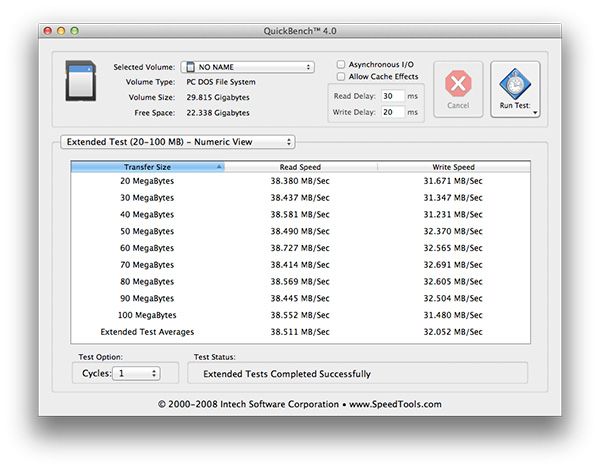
The rMBP by comparison can deliver more than 80MB/s in the read portion of this test. Even writes are faster at ~40MB/s on the rMBP compared to around 32MB/s here. It's a lot of these little things that contribute to the differences between Apple's MacBook Air and Pro lines.
WiFi Performance
Wireless connectivity remains unchanged from last year's model. Broadcom is on 802.11n WiFi duty with its BCM4322. Both 2.4GHz and 5GHz bands are supported. The same 2x2:2 configuration (2 send and receive antennas with 2 spatial streams) remains from last year as well.

I ran the 13-inch MacBook Air through the same three location WiFi test that I put the rMBP and 2011 MBP through, on both 5GHz and 2.4GHz. Performance on 2.4GHz was unusually low on the Netgear WNDR4500 I usually test with (10 - 20Mbps regardless of location) so I had to switch to the previous generation Apple Time Capsule to ensure there was nothing wrong with the notebook itself. All of the 2.4GHz MBA numbers have a star next to them to indicate that they aren't totally comparable as they're using a different AP. The 5GHz numbers all came from the Netgear however.
| Location 1 | Location 2 | Location 3 | |
| 2011 MacBook Pro (2.4GHz) | 124.0 Mbps | 12.6 Mbps | 61.6 Mbps |
| Retina MacBook Pro (2.4GHz) | 117.9 Mbps | 87.6 Mbps | 44.0 Mbps |
| 2012 MacBook Air (2.4GHz) | 95.7 Mbps* | 75.2 Mbps* | 31.2 Mbps* |
| 2011 MacBook Pro (5GHz) | 186.8 Mbps | 154.6 Mbps | 24.7 Mbps |
| Retina MacBook Pro (5GHz) | 227.7 Mbps | 156.8 Mbps | 33.7 Mbps |
| 2012 MacBook Air (5GHz) | 159.4 Mbps | 97.0 Mbps | - |
Overall WiFi performance is decent but obviously not as good as what you get from a MacBook Pro. Looking back at the results I almost wonder if the 2011 MBP wasn't showing some of these weird 2.4GHz issues on the Netgear router as well.
In the best conditions on 5GHz you can hit around 160Mbps, but you pretty much have to be right next to a good AP for that to work. Across a large room or in an adjacent one just under 100Mbps is possible on 5GHz as well. Go further out and you'll have to switch over to 2.4GHz.
There are no wired network options by default, however Apple's Thunderbolt to Gigabit Ethernet adapter works just fine on the new Air as well as the rMBP.
MagSafe 2
MagSafe 2 makes an appearance on the new MacBook Air, although it's curiously absent from the non-retina MacBook Pro. Eventually I'd expect all Macs to use MagSafe 2. The current state of things is likely temporary fragmentation. Similar to the rMBP, the actual power adapters themselves haven't changed: 45W is all you need for both systems.
Ivy Bridge on Air
Apple keeps its CPU options pretty simple and straightforward. You get a choice of three different CPUs, all dual-core, all rated at a 17W TDP. The Core i5-3317U comes standard in the 11, the i5-3427U comes with the 13, and both systems can be upgraded to the Core i7-3667U.
The breakdown between the chips is below:
| Apple 2012 MacBook Air Comparison | |||||
| 1.7GHz dual-core | 1.8GHz dual-core | 2.0GHz dual-core | |||
| Standard On | 11-inch MBA | 13-inch MBA | Optional for Both | ||
| Intel Model | Core i5-3317U | Core i5-3427U | Core i7-3667U | ||
| Base Clock Speed | 1.7GHz | 1.8GHz | 2.0GHz | ||
| Max SC Turbo | 2.6GHz | 2.8GHz | 3.2GHz | ||
| Max DC Turbo | 2.4GHz | 2.6GHz | 3.0GHz | ||
| L3 Cache | 3MB | 3MB | 4MB | ||
| AES-NI | Yes | Yes | Yes | ||
| VT-x | Yes | Yes | Yes | ||
| VT-d | Yes | Yes | Yes | ||
| TDP | 17W | 17W | 17W | ||
| Processor Graphics | Intel HD 4000 | Intel HD 4000 | Intel HD 4000 | ||
| GPU Clock (Base/Max) | 350/1050MHz | 350/1150MHz | 350/1150MHz | ||
The Core i7 upgrade is likely worth it if this is going to be your primary system for an extended period of time, particularly if it's acting as a desktop replacement. As a mobile device the standard CPUs are quite fast. If you're an annual upgrader, save your money, but if you're going to hold onto the system for a while and do a lot of heavy work on it, the upgraded CPU is probably worth it.
There is a known bug with the upgraded CPU under Windows today. Turbo Boost is disabled under Windows on the 3667U, although it's fully functional under OS X. Apple is aware of the problem and I'd expect a fix at some point, but there's no indication of when.


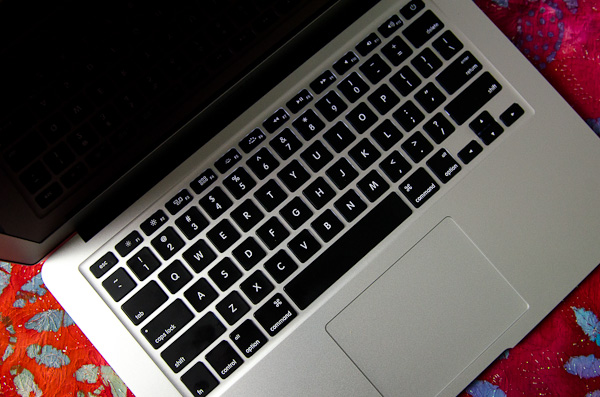
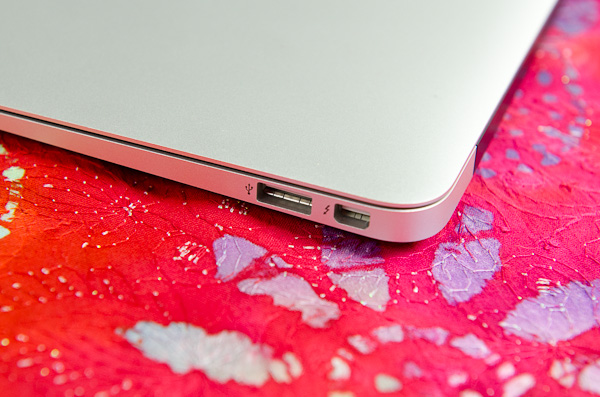

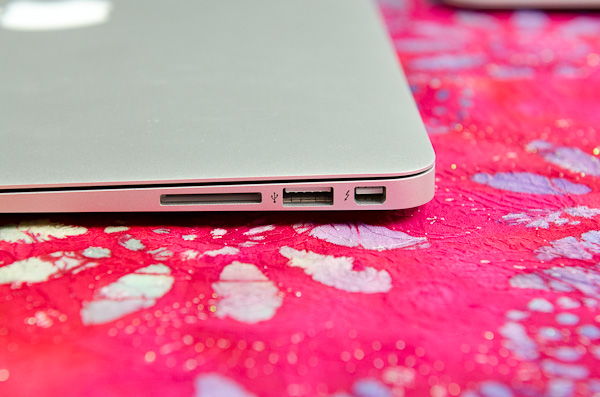
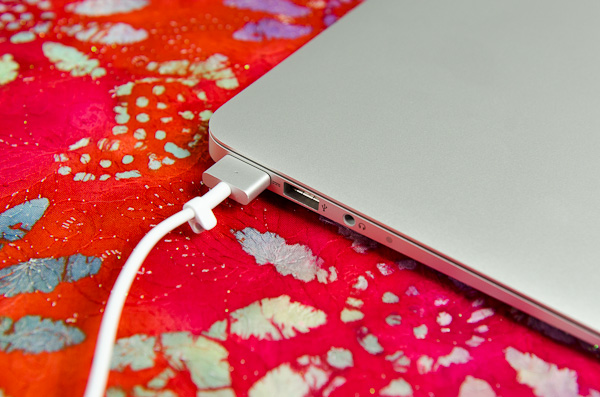








190 Comments
View All Comments
ShadeZeRO - Monday, July 16, 2012 - link
I'm curious as to why you haven't held the apple line to the normal scrutiny typically found in your other notebook reviews.I've noticed a certain level of bias on most review sites most likely caused by the sudden trend in popularity of Apple products.
If this was branded differently I'm positive the display for one would have been ridiculed as a poultry offering.
Overall a fine review, it's not on the level of a gizmodo/engadget/etc apple circle jerk so I still respect it.
/rant
KoolAidMan1 - Tuesday, July 17, 2012 - link
He criticized the display and compared it unfavorably against other ultrabooks that use IPS panels. It is one of the few points of criticism, but its there. Is your problem that he doesn't say that the MBA is a complete piece of trash?Anand gave a very well balanced review as per usual.
Super56K - Tuesday, July 17, 2012 - link
I would gladly take a 1440x900 TN display like the Air's in a 13" Sandy/Ivy Bridge Windows laptop.notposting - Tuesday, July 17, 2012 - link
Paltry offering.Unless they are offering up some turkeys, ducks, and chickens for sacrifice.
Alameda - Tuesday, July 17, 2012 - link
First of all, Anand, I want to tell you that you've once again written up an excellent review, and I'm very impressed with your thoroughness and clarity. I just purchased a 2011 MBA, so of course I read your review to justify that I made the right decision. While I understand the need for benchmarks and the real-world tests such as Photoshop and so forth, I think most people do not use their computers the way your tests imply.In my daily use, the performance bottleneck I experience is when making a Time Machine backup, which the new machines should improve upon -- USB 2.0 is very slow, and Thunderbolt drives are too expensive. USB 3.0 is the right solution for most users. I would also like to see networking tests. This machine needs wifi to work, and there's a lot of performance variance from one 802.11n to another. Last, sincecthe RAM is soldered, adding guidance about memory use would be useful. On my MBA, if I open all of my applications at once (except VMWare), I use less than 2 of my 4 GB of RAM. So it seems to me that 8+ GB only matters if you have a specific power-user need, particularly in a simultaneous Mac/Windows setup, but for most users, 4 GB and the stock CPU exceeds what you can use.
I personally think these sorts of real world tests would make your reviews better reflect what most users actually do. I also feel that many people want to make excuses for taxing a machine to its limits, but we simply don't have such issues in actual use.
name99 - Tuesday, July 17, 2012 - link
Basically 2GiB is tight for pretty much any OSX user nowadays, but swapping on even the 2011 SSDs is fast enough that you don't really notice it. You can live it, but you will notice occasional pauses.You want 4GiB if you tend to keep a lot of browser windows open. Safari is a pig in this respect (hopefully improved somewhat in ML) and Chrome is not that much better.
My collection of always-running apps is Finder, Mail, iChat, Skype, iTunes and Safari; something like this is, I think, pretty standard across most users. That, with 20 or so browser windows, will fit OK in 4GiB, but will start obviously paging if you add a few more apps, eg throw in Word or Excel or an Adobe app.
(
Where does it go?
Essentially the OS is using about 500MB for misc [process management, memory management, network buffers, that sort of thing] and about 1GB for file buffers of various sorts. Of the 2.5 GB that's left, the worst offenders:
WebProcess, essentially the guts of Safari, is currently using 1.2GB which is pathetic, the actual Safari process, basically UI, is using 200MB, also pathetic, and iTunes is using 530 MB --- TRULY pathetic, but what else would you expect from, iTunes, apparently the team to which Apple retires their most doddering and incompetent programmers.
)
For most people, however, I'd recommend 8GiB purely because
- it's not that much more in cost.
- you may not need it now, but you're future-proofing yourself since most normal people use their laptops for at least 3yrs before replacing them
- the extra retail value when you do retire it is probably worth more than the extra cost now --- just think of the comparable desirability today of a 2GB vs a 4GB 2010 MBA.
Freakie - Tuesday, July 17, 2012 - link
I'd definitely agree with you that 8GB really should be what most people get. Even though they wont know or understand the difference, it makes a difference in how much they will enjoy any computer, PC or Mac. You just never know when someone will do something that eats up a ton of RAM, whether it be running a game without closing their browser, or opening up 100+ browser tabs, 4 word documents, and 4 excel books (my girlfriend does that a lot, and it makes her 8GB rather unhappy).And if you have an Windows computer with a 64bit install, more RAM is even more important for getting the best possible experience. While I can't say while OSX seems to have such RAM hungry programs that don't offer performance gains for so much usage, I can say that I put specific 64bit programs on my Windows laptop knowing that they will perform better and be able to use more RAM and use it more effectively. My 64bit Firefox browser is a great example of that. I don't mind it using 2-3GB of RAM because I have a crap ton of stuff open, multiple flash based videos, a flash game, ect... because it's just a nice experience. Not to mention this 64bit version is way faster than the regular one :P Regular users could be having these nice experiences too if the general consensus on what a good amount of RAM is would increase.
On a side note... I'm thinking of going up to 16GB on my laptop, maybe 24GB... Just because I'm greedy :P Might even go the full 32GB and put a RAMdisk... who knows! So many possibilities when you have MORE RAM!
phillyry - Tuesday, March 26, 2013 - link
'Future proofing' = illusionHere's your future proofing. Buy what you need now of will likely need in the near future and save your pennies (or, in this case hundreds of dollars with of upgrades) for your next upgrade. And by upgrade, I mean your next laptop or whatever the hell else you want to do wig your money. Why leave an extra $100 lying inside a computer chassis in the shape of some soldered on RAM, if you can keep that money in your bank account and buy whatever else you want or, maybe even, actually need with it.
Really, the upgrades should only be for the hardcore users and should not be a concern for most people.
name99 - Tuesday, July 17, 2012 - link
What sort of compression does Sandforce use?More specifically, I imagine that within a file they use some sort of LZ variant --- it's easy, it's known to work well for this sort of problem, and there's hardware to handle it.
More interesting is the question of what sort of cross-file de-duplication they use. The obvious thing would be some sort of hash of each 4kiB block to something like a 128b signature, then compare each incoming block to that map. But that would require an in-memory table of hashes that would be of order 256MiB in size for a 64GB drive (and twice that for a 128GB drive), which, while obviously technically possible, doesn't seem to match their actual hardware setup. You could drop the hash to 64b, at the cost of more frequent collisions (and thus having to waste time reading the drive to compare with the incoming block) and that would halve your table size --- again possible, but still looking like it uses more RAM than they have available.
So what's the deal? They don't actually do cross block de-dup? They do it in some fashion (eg using larger blocks than 4kiB) which, while it works, is not as optimal for small files?
desmoboy - Tuesday, July 17, 2012 - link
Excellent Review Anand. Do you have a explanation why the 13" MBA i7 is 28 sec slower in the iMovie '11 (Import + Optimize) benchmark than the i5 version? Seems bit strange when the i7 scores higher on every other of your benchmarks (as one would expect)